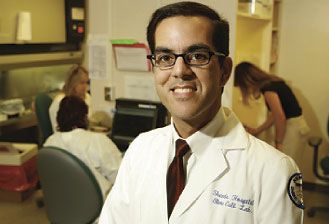Christopher Cogle, M.D., Professor of Medicine, University of Florida, Pierre Chagnon Professor of Stem Cell Biology and Bone Marrow Transplant, is the recipient of an LLS Scholar in Clinical Research grant through our Career Development Program. He also has a project supported through LLS’s Therapy Acceleration Program. Dr. Cogle explains his work advancing an investigational approach to treating patients with acute myeloid leukemia and myelodysplastic syndromes.

How would you explain your research in the simplest terms?
My research group discovered that blood vessels are sanctuary sites for leukemia. We found that leukemia cells like to nestle within the walls of blood vessels where they take a nap. While napping, leukemia cells are resistant to traditional chemotherapy like cytarabine or daunorubicin. We also found that napping leukemia cells can awake and regrow. My research group took this information and created three projects. The goal of the first project was to find a new drug that could force the leukemia cells to awaken by rousting them from their beds within blood vessels and then deliver the traditional chemotherapy. The intent of this project was to immediately provide new treatment for patients with acute myeloid leukemia (AML) and myelodysplastic syndromes (MDS). The goal of the second project was to find new drugs that killed leukemia cells despite their hiding within blood vessel walls. This was expected to be a longer-term project, but has already led to the discovery of two new anti-cancer drug groups. The goal of the third project was to combine all of our scientific methods with gene testing and computer modeling, so that we could create a personalized medicine program for patients with blood cancers.
Why is your strategy to target tumors different from conventional approaches and how might it help overcome drug resistance?
Our strategy stands out from others because we are removing the protective nest around leukemia cells. Our research has shown us that blood cancer cells don’t grow on their own. Leukemia cells hijack normal tissues like blood vessels and change the blood vessels so that the leukemia cells become their masters. By forcing the leukemia cells to lift off of blood vessels with our new drugs, we’ve made the leukemia more susceptible to traditional chemotherapy.
How close are you to finding a therapy that might be an option for AML patients?
We have already translated a new drug into the clinic. This vascular disrupting agent is the world’s first clinical trial of this approach in patients with blood cancers. We have also discovered two new drug classes for patients with leukemia and cancer. We are developing these drugs for clinical treatment.
What is the status of your clinical trials?
Currently, our clinical trial of the vascular disrupting agent, OXi4503, in combination with cytarabine is in Phase IB testing for patients with relapsed/refractory AML and advanced MDS. Here is the website: https://clinicaltrials.gov/show/NCT02576301. The trial is open at four centers including University of Florida (PI: Chris Cogle, M.D.), University of Miami (PI: Ronan Swords, M.D., Ph.D., and Justin Watts, M.D.), Kansas University Medical Center (PI: Tara Lin, M.D.), and UCLA (PI: Gary Schiller, M.D.).
In June 2015, we launched our personalized medicine program, iCare for Cancer Patients. Our first clinical trial entitled “iCare 1” has recruited over 90 patients and is establishing the predictive values of our methods in forecasting disease response to treatment. Here is the website: https://clinicaltrials.gov/show/NCT02435550.
What have you learned so far from the early phase clinical trial that may help strategize future studies?
Early phase clinical trials have thousands of moving parts. To lead early phase clinical trials, I need a team of intelligent, high-energy and persistent scientists, trial coordinators, data entry staff, clinicians, pharmacists, nurses and many others. Recruiting and retaining these people are crucial. I greatly appreciate the support from The Leukemia & Lymphoma Society, because they have enabled me to keep and grow a fantastic team of specialists who come to work every day to find cures for patients with blood cancers. My team and I personally donate to The Leukemia & Lymphoma Society because we know the value and care by which the Society puts our donations to work.
